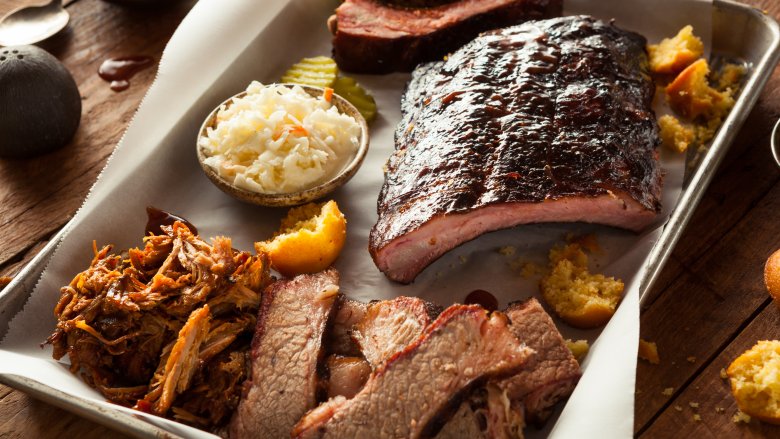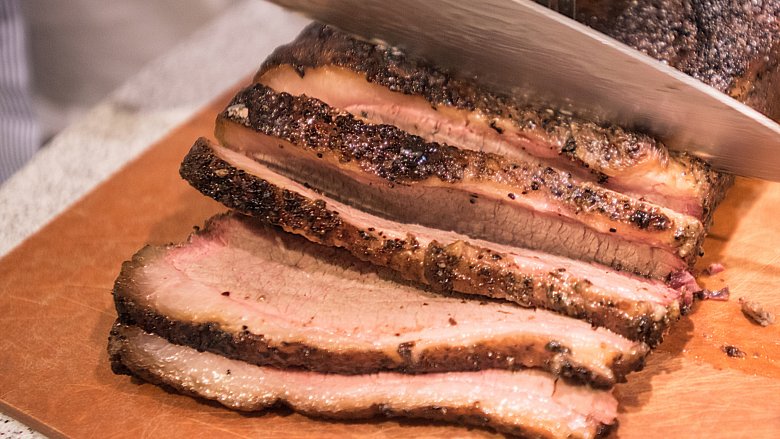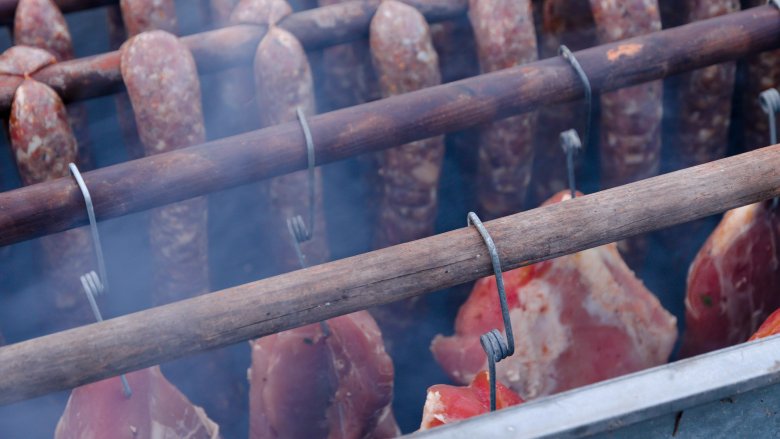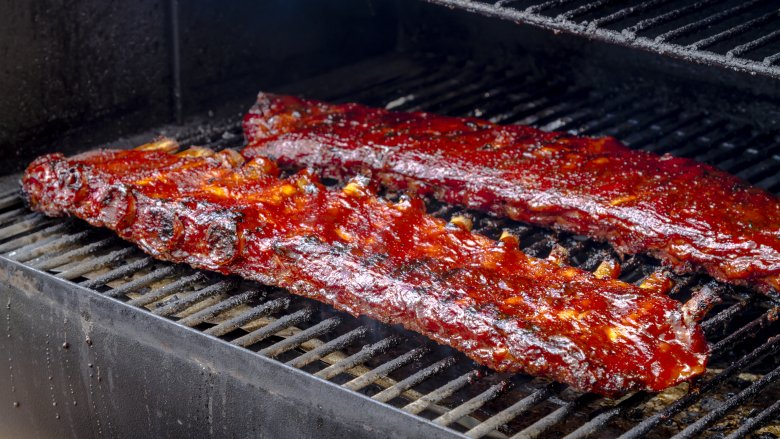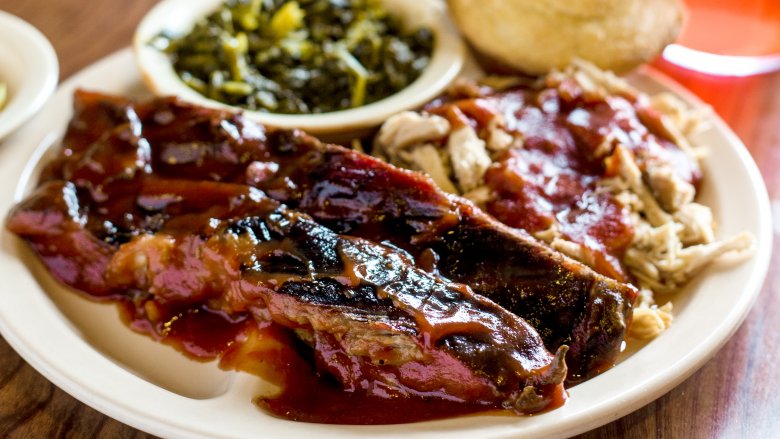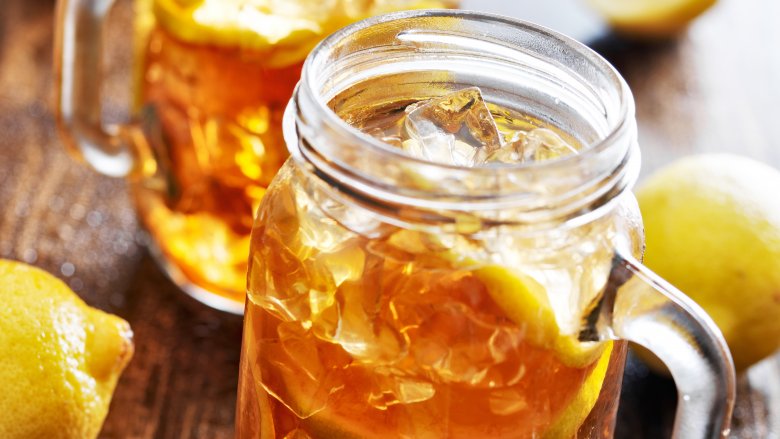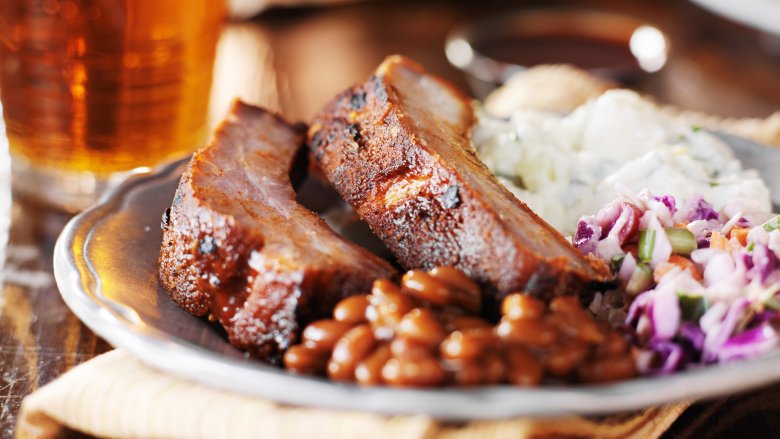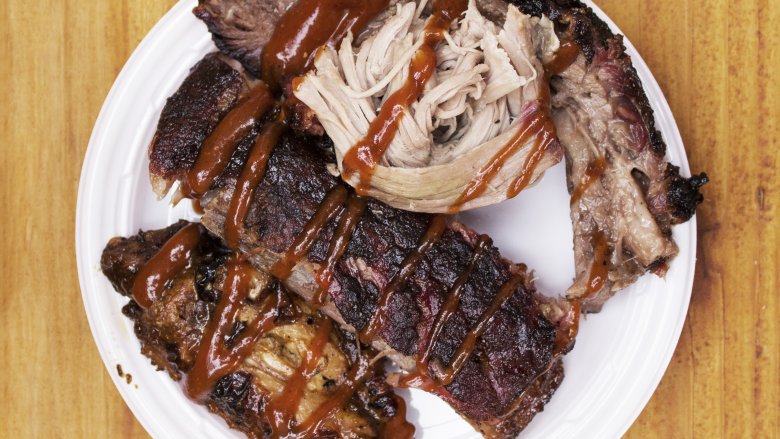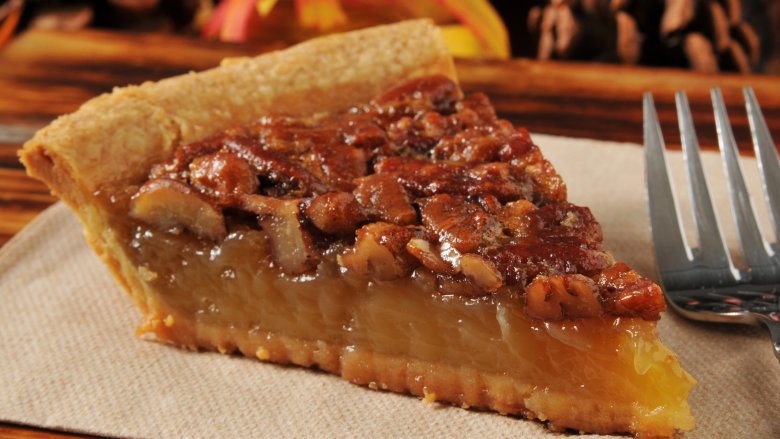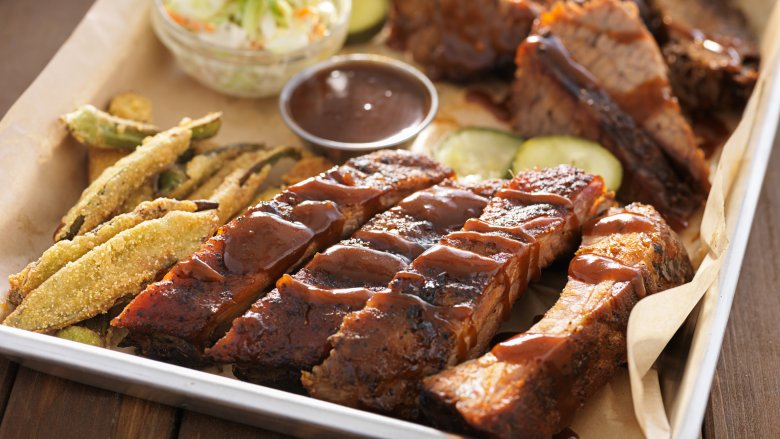Ways To Tell You're At Fake Barbecue Joint
As someone who grew up in North Carolina (one of the places in the U.S. known for great barbecue), I've been to my fair share of great barbecue joints. I've also been to my share of really terrible ones just masquerading as the real thing. If you want great 'cue, there are some areas where you just can't compromise. Here's how to tell if the barbecue joint in your neighborhood is one you'd be better off avoiding.
You go late in the day and they still have brisket
One of the best things at a barbecue joint is brisket, but the best brisket isn't something you can get made to order. It takes time. According to Steven Raichlen's Barbecue Bible, the secret to a tender brisket is to cook it low and slow. In fact, he recommends a cooking temperature of 215 to 225 degrees Fahrenheit with a cook time of 15 to 20 hours "to melt the collagen, fat, and other tough connective tissue in the brisket."
Yes, you read that right, 15 to 20 hours. That means that when a real barbecue restaurant runs out brisket for the day, that's it until the next batch has had nearly a full day to cook. The same thing goes for a lot of the other meat in general, so don't be surprised if you head to a popular barbecue place late in the evening only to find it closed because they're out of meat for the day.
You spot liquid smoke or don't spot a smoker
Speaking of how barbecue should be cooked, the real key to the perfect texture and flavor comes from a smoker. But frankly, a smoker means lots of work (continually feeding it with wood chips, for instance) and a lot of restaurants take a shortcut with liquid smoke. While it doesn't impart the same texture as a smoker, it does at least sort of mimic the flavor of a real smoker. And with good reason. It was invented in 1895 by condensing actual smoke into liquid form.
The thing is, it was never meant to replace smoke flavor (it was marketed as a preservative). That might be why barbecue purists loathe it as reminiscent of "creasote [sic], formaldehyde, termite mounds, the tears of mendacious orphans, crawlspaces, the acidic musk of old age homes, guano caves, vinegar, and bad barbecue." In short, it's no real substitute for the real thing, so if you don't spot a smoker at the restaurant you're at, they're likely using liquid smoke in an attempt to infuse that smoky flavor without one. Hard pass.
The ribs fall off the bone
You've seen or heard it before: restaurants love to advertise that their "meat falls off the bone." But when it comes to ribs, if the meat sloughs off easily, it means they were probably boiled before being baked or grilled. Boiling, however, means that you're going to lose a lot of the great flavor inherent in the meat. While no one wants tough ribs, there's a happy, chewy medium that comes from treating ribs the way you treat brisket: cook it low and slow in the smoker. This will lead to tender meat, but you'll still need to tear it off with your teeth.
All the meat comes with sauce slathered on it
Good barbecue uses sauces (at most) as an accompaniment to enhance the meat's natural flavor. Or, in the case of ribs, to help keep the meat tender and juicy while it cooks (though really, at a good place, ribs are kept tender and juicy with a combination of a dry rub and a rib mop). If you order meat and it arrives covered in sauce, it's probably serving the purpose of covering something else as well (like dry meat, super fatty cuts, or lack of seasoning in general). The best barbecue doesn't require any sauce at all.
There's no sweet tea to be found
Everyone knows the best barbecue in the U.S. comes from the South (where in the South is debatable, but I'm obviously team NC). That said, a real barbecue restaurant is going to have side dishes and drinks that mirror those southern roots. As Time notes, that's part of the reason cornbread became the side of choice for barbecue. If you've ever seen Steel Magnolias, you'll also know that sweetened iced tea "is the house wine of the South," which means it's also the preferred beverage to drink alongside barbecue. No sweet tea at a barbecue place means the person running the restaurant has probably never had 'cue from the South.
The sides are healthy
While we're on the subject of what you should have alongside your barbecue, let's go ahead and admit it: barbecue isn't meant to be healthy. If the sweet tea and cornbread didn't already tip you off, maybe the potato salad, baked beans, macaroni and cheese, mayo-dressed coleslaw, and pork fat seasoned collard greens will.
If you're staring down options like a side salad, sauteed mixed vegetables, or some other healthy version of a side dish, you're not at a real barbecue joint. Oh, and let's take it one step further at risk of stating the obvious. No self-respecting barbecue restaurant is going to be serving any of those sides out of a jar, can, or tub. Homemade is the only way to go.
You can order any regional specialty
We've already mentioned that there are different styles of barbecue for different regions of the U.S. (and that's not to even take into account specialties from regions outside the U.S. like Korean barbecue and barbacoa). But the thing about a really great barbecue place is that they're going to specialize in just one style (Memphis, Texas, North Carolina, South Carolina, etc.).
Part of that is because, as we've mentioned, great barbecue takes time and technique. If a restaurant is spending hours perfecting Texas beef brisket, the chances that they're also taking the time to perfect Memphis pulled pork are slim. A place that serves several regional specialties isn't taking the time to do any of them properly. That or their sauces and meats come pre-made, which also isn't a good sign.
The restaurant is famous for something other than their meat
As great as barbecue restaurant side dishes may be, there's no denying that the star of a barbecue joint should be the meat. Don't get me wrong, some of the best barbecue restaurants around also have really stellar sweet potato pie or perfectly crisp fries, but nothing comes close to the perfection of the meat. So if the place you're at is more well-known for their cocktail list or something like a hamburger, you're probably not at a real barbecue place. Don't waste your time.
Your food is served on fancy dishes
Many great barbecue restaurants either started or still double as meat markets where you could buy raw meat for your own home use. This means that one thing always at the ready was butcher paper. If you're already using it to wrap up cuts of meat to go, why not also serve your cooked meat on it too? That's exactly what's behind all those butcher paper-lined trays you'll see at a lot of authentic barbecue joints.
In other places the butcher paper may be used to line baskets instead of trays or you might even find your food served on paper plates. The key thing is that you're not going to be eating off great grandma's best china. And barbecue restaurants had people drinking out of Mason jars before drinking out of Mason jars was cool. When the star of your restaurant is the meat, little else matters.
